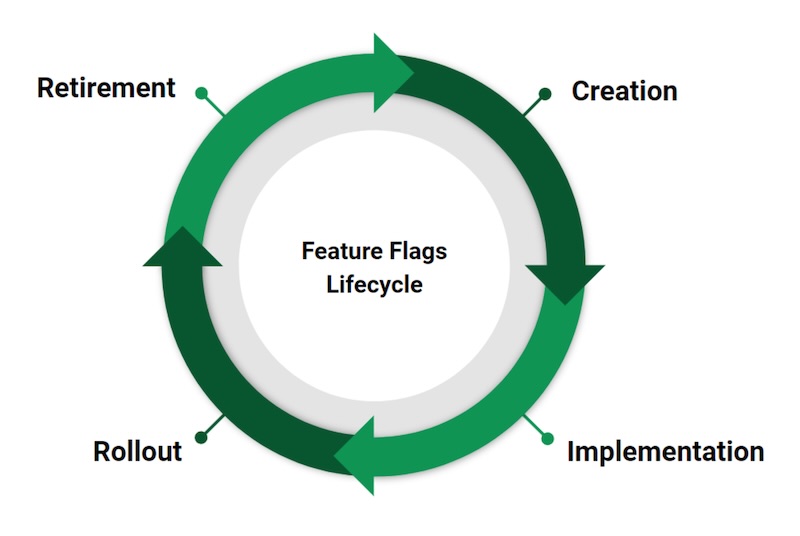With the constant growing digitalization, our lives are continually enhanced by innovative features that simplify daily tasks. Central to this seamless integration of new functionalities is the concept of feature flagging—a powerful tool that allows developers to effortlessly toggle software components on or off.
This flexibility enables modifications without the need to redeploy or risk breaking the entire software infrastructure, offering tailored experiences to specific clients, regions, or user groups. Feature flags extend beyond mere software development, unlocking a plethora of versatile applications across various domains.
However, the utility of feature flags is primarily intended for temporary use and demands a strategic approach for their retirement. Hence, understanding the nuances of feature flag retirement is essential in maintaining an efficient and clean codebase.

Understanding Feature Flags and The Need for Retirement
Feature flags are toggles used to enable or disable software application functionality without downtime caused by deployment. This concept, believed to have originated as a practical solution for common development challenges, has evolved into a critical tool across various industries. Its genesis is rooted in the need for safer, more controlled release processes in an increasingly complex software landscape.
Feature flags find their utility in diverse scenarios, including:
Gradual Rollouts: They enable the release of features without the stress of breaking the application for all users. For instance, a feature can be tested on a small user segment before a full rollout.
Targeted Releases: Feature flags allow for feature activation based on specific criteria such as geographic location, user demographics, or subscription types.
A/B Testing: They enable real-time production tests, which can provide insight into actual data flow and user engagement.
Deprecation and Removal: They provide safe removal or replacement of outdated or problematic features.
However, the lifecycle of a feature flag doesn't end with its implementation—it culminates in its retirement.
Feature Flag Lifecycle: Timing Their Retirement
While feature flags are invaluable tools, they are intended to be temporary. Prolonged use without maintenance can lead to increased technical debt. Understanding when and how to retire feature flags is crucial to maintaining code hygiene and minimizing technical debt.
The retirement of a feature flag should be planned from its start. However, complexity or specific requirements may necessitate a longer lifespan.
But why would you remove something helpful so fast?
- They are temporary residents of the code at best.
- They add to the technical debt.
- They are created for one specific purpose.

When to retire feature flags
The short and best answer would be as soon as they outlive their original purpose. But, in most cases, it is more complex. Sometimes, due to the complexity of the feature or implementation, the flag must stay in place for a more extended period, or it requires additional work to be removed entirely.
How to retire feature flags
Proper initial setup allows for straightforward deletion of a feature flag when it's no longer needed, including removing all references to it in the codebase; in the long run, this keeps the codebase clean and open for future implementation and changes.
While most feature flags are retired promptly after their purpose is served, some are designed for long-term use, often to meet specific needs. As the codebase expands and technical debt accumulates, it is a good idea to implement feature flags using a feature flag management system like ConfigCat, which can help track and maintain the flags.
It also allows setting flag expiration dates, which aligns with the retirement strategy. Additionally, it has different reports and alert reminders, which can help with tracking and aid in efficient flag management.
Code hygiene and technical debt
Technical debt, akin to financial debt, accumulates 'interest' if not managed timely, often manifesting during critical phases of development. Improperly managed feature flags contribute to this debt, especially when they become obsolete yet remain in the codebase.
As previously noted, technical debt frequently burdens the code of applications, particularly those decades old. This accumulation results from years of improper practices and design choices. Various factors contribute to technical debt, including feature flags. Specifically, those flags that are not retired and remain in the codebase for extended periods contribute to this debt.
Pro tip: ConfigCat has a great read that describes the importance of clean code in more depth.
Tips and tricks
Here are some simple tips that can help retire flags.
- Plan Early: Assign a definite retirement date during the flag's creation.
- Regular Reviews: Periodically revisit existing flags to assess their relevance and usage.
- Avoid Long-Term Flags: Minimize flags intended for extended periods.
- Leverage Management Tools: Utilize features offered by feature flag management systems for more efficient handling.
Stale flag report
ConfigCat has an excellent and handy tool that will help keep track of all the flags to monitor all feature flags, especially those that have become stale. This tool can significantly reduce technical debt, ensuring the code remains clean and well-organized.
To sum it up
Begin planning for a feature flag's retirement early, ideally before its creation. Incorporating this into the team's best practices for managing feature flags will yield long-term benefits. When it's time for retirement, the process will be straightforward, helping to keep technical debt manageable.
For ease of management, utilize tools offered by feature flag systems, such as the stale flag report. These tools help you stay informed about all updates and deadlines related to releases or features.
Deploy any time, release when confident. And remember, if you want to learn more about the feature flags or stay up to date with all the news, check out the ConfigCats social hub:
